
The Game Boy Advance (GBA) is a 32-bit handheld game console developed, manufactured and marketed by Nintendo as the successor to the Game Boy Color. It was released in Japan on March 21, 2001, in North America on June 11, 2001, in the PAL region on June 22, 2001, and in mainland China as iQue Game Boy Advance on June 8, 2004.

Super Mario 64 DS is a 2004 platform game developed and published by Nintendo for the Nintendo DS. It was a launch game for the DS. Super Mario 64 DS is a remake of the 1996 Nintendo 64 game Super Mario 64, with new graphics, characters, collectibles, a multiplayer mode, and several extra minigames. As with the original, the plot centers on rescuing Princess Peach from Bowser. Unlike the original, Yoshi is the first playable character, with Mario, Luigi, and Wario being unlockable characters in early phases of the game.
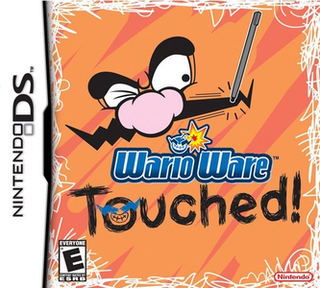
WarioWare: Touched! is a minigame compilation party video game released by Nintendo for the Nintendo DS. The fourth installment of the WarioWare series, and the first of three on the Nintendo DS, the game involves rapidly completing "microgames" — simple minigames lasting extremely short periods of time — as quickly as possible. The microgames are exclusively controlled with the Nintendo DS's touchscreen and microphone.

Nintendogs, styled as "nintendogs", is a real-time pet simulation video game developed and published by Nintendo for the Nintendo DS handheld video game console. It was released in Japan, and was later released in: North America, Australia, New Zealand, Europe and other regions. It was originally released in three different versions: Dachshund & Friends, Lab & Friends and Chihuahua & Friends. It has been re-released twice, first as a bundled release with a special edition Nintendo DS with a new version called Nintendogs: Best Friends and later as Nintendogs: Dalmatian & Friends.

Adventures of Lolo is a puzzle video game released in 1989 by HAL Laboratory for the Nintendo Entertainment System. It is a compilation of puzzles from Eggerland: Meikyū no Fukkatsu and Eggerland: Sōzō he no Tabidachi. It is the fifth game in the Eggerland series, the third one released in Europe, but the first one released in North America. It was available on the Wii's and Wii U's Virtual Console in North America and in PAL regions, as well as on the Nintendo Switch Online's virtual Nintendo Entertainment System library.

WarioWare: Twisted! is a video game for the Game Boy Advance, developed by Nintendo SPD with Intelligent Systems and published by Nintendo. It was released on October 14, 2004 in Japan; May 19, 2005 in Australia; and May 23, 2005 in North America. The second game in the WarioWare series and the seventh in the Wario series overall, Twisted! was the last Wario game to be released on a Game Boy family system.
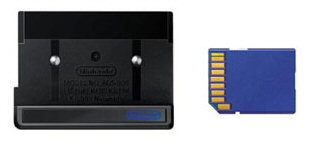
The Play-Yan is a media player designed for the Game Boy Advance SP and also compatible with the Game Boy Micro and Nintendo DS. It uses SD flash memory to play MP3 audio files and H.264/MPEG-4 AVC video files. It can also play 13 bonus mini-games, all of which are available freely on the Nintendo website in Japan. Sales of the Play-Yan were discontinued on September 11, 2005.

Rhythm Tengoku is a rhythm game developed and published by Nintendo for the Game Boy Advance. It was originally released on August 3, 2006, and was the last game released by Nintendo for the Game Boy Advance. An arcade version of the game was reprogrammed and published by Sega on September 20, 2007. Both versions were released in Japan exclusively. The game was the first in the Rhythm Heaven series which spawned three international sequels; Rhythm Heaven, Rhythm Heaven Fever, and Rhythm Heaven Megamix. It began as an idea created by its composer and supervisor Tsunku, who proposed it to Nintendo due to his belief that they could do a better job with it than he could.

Nintendo Software Planning & Development Division, commonly abbreviated as Nintendo SPD, was a Japanese research, planning and development division owned by Nintendo and housed inside the Nintendo Development Center in Kyoto, Japan. The division had two departments: Software Planning & Development Department, which primarily co-produced games with external developers; and Software Development & Design Department, which primarily developed experimental and system software. The division was created during a corporate restructuring in September 2003, with the abolition of the Nintendo R&D1 and Nintendo R&D2 departments.

MySims Party is a video game developed and published by Electronic Arts as a spinoff to Maxis' The Sims franchise for the Nintendo DS and Wii in 2009. It is the third game in the MySims series. It consists of 50+ mini-games which can be played with up to 4 players. The game was released on March 10, 2009, in North America.
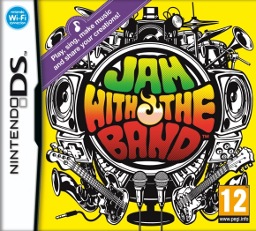
Jam with the Band, known in Japan as Daigasso! Band Brothers DX, is a music video game developed and published by Nintendo for the Nintendo DS handheld game console. It is the sequel to the Japan-exclusive Daigasso! Band Brothers, which was released at the DS' launch. Jam with the Band was released in Japan in June 2008 and in Europe in May 2010. It uses the largest save capacity for a Nintendo DS game at eight megabytes. Its release was accompanied by a Wii Channel for the Wii console called the Live Channel, known in Japan as the Speaker Channel, that allows players to hear the game's sound through their television. It features the character Barbara Bat, who was also in the predecessor.
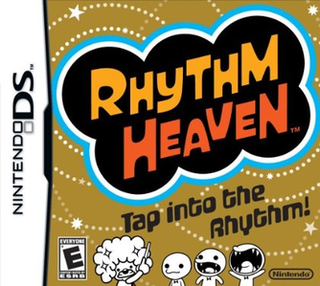
Rhythm Heaven, known as Rhythm Tengoku Gold in Japan, Rhythm Paradise in Europe, and Rhythm World in Korea, is a rhythm video game developed and published by Nintendo for the Nintendo DS. It is the second game in the Rhythm Heaven series and the first one released worldwide, following the Japan-only Game Boy Advance title Rhythm Tengoku, and was succeeded by Rhythm Heaven Fever for the Wii and Rhythm Heaven Megamix for the Nintendo 3DS. The game was released in Japan on July 31, 2008, in North America on April 5, 2009, in Europe on May 1, 2009, and in Australia on June 4, 2009.

The Nintendo DSi is a dual-screen handheld game console released by Nintendo. The console launched in Japan on November 1, 2008, and worldwide beginning in April 2009. It is the third iteration of the Nintendo DS, and its primary market rival was Sony's PlayStation Portable (PSP). The fourth iteration, entitled Nintendo DSi XL, is a larger model that launched in Japan on November 21, 2009, and worldwide beginning in March 2010. Development of the DSi began in late 2006, and the handheld was unveiled during an October 2008 Nintendo conference in Tokyo. Consumer demand convinced Nintendo to produce a slimmer handheld with larger screens than the DS Lite. Consequently, Nintendo removed the Game Boy Advance (GBA) cartridge slot to improve portability without sacrificing durability.

Mario & Sonic at the Olympic Winter Games is a 2009 sports and party game developed by Sega. Like its predecessor, it was published by Nintendo for Japan and Korea and by Sega in the Western world. The game is officially licensed by the International Olympic Committee (IOC) through exclusive license International Sports Multimedia. The game is the third official crossover title to feature characters from both Mario and Sonic's respective universes, the first and second being the game's predecessor Mario & Sonic at the Olympic Games and Super Smash Bros. Brawl respectively. It was released on the Wii and the Nintendo DS in October 2009, and is the first official video game of the 2010 Winter Olympic Games.

Guitar Hero: On Tour is a series of music video games based on the Guitar Hero series for the Nintendo DS handheld game system. The series is developed by Vicarious Visions and published by Activision. Three games in the series have been released since June 2008: Guitar Hero: On Tour, Guitar Hero On Tour: Decades, and Guitar Hero On Tour: Modern Hits.

Rhythm Heaven Fever, known in the PAL regions as Beat the Beat: Rhythm Paradise, Minna no Rhythm Tengoku in Japan and Rhythm World Wii in Korea, is a music video game developed by Nintendo and TNX for Nintendo's Wii. It is the third game in the Rhythm Heaven series, following Rhythm Tengoku for the Game Boy Advance and Rhythm Heaven for the Nintendo DS, and was succeeded by Rhythm Heaven Megamix for the Nintendo 3DS in 2016. The game was released in Japan on July 21, 2011, in North America on February 13, 2012, in Europe on July 6, 2012, and in Australia on September 13, 2012. It was digitally re-released for the Wii U in Japan on July 27, 2016, in North America on November 10, 2016, and in Europe on November 22, 2016.
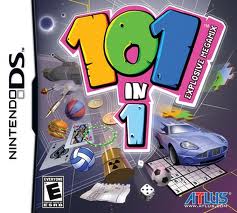
101-in-1 Explosive Megamix is a video game developed by Nordcurrent and published by Atlus for the Nintendo DS. It was released in Europe on November 28, 2008 and features 10 hours' worth of 101 minigames. A version for the WiiWare service was released on September 22, 2011 in Europe and on October 13 in North America.

Rhythm Heaven Megamix, known in Europe and Australia as Rhythm Paradise Megamix, and in Japan as Rhythm Tengoku: The Best Plus and Rhythm World: The Best Plus in Korea, is a rhythm game developed and published by Nintendo for the Nintendo 3DS. It is the fourth game in Nintendo's Rhythm Heaven series and compiles stages from the series' previous entries; Rhythm Tengoku, Rhythm Heaven, and Rhythm Heaven Fever, as well as adding new ones. The game was released in Japan in June 2015 and in North America, Europe, Oceania, and South Korea throughout 2016.


















